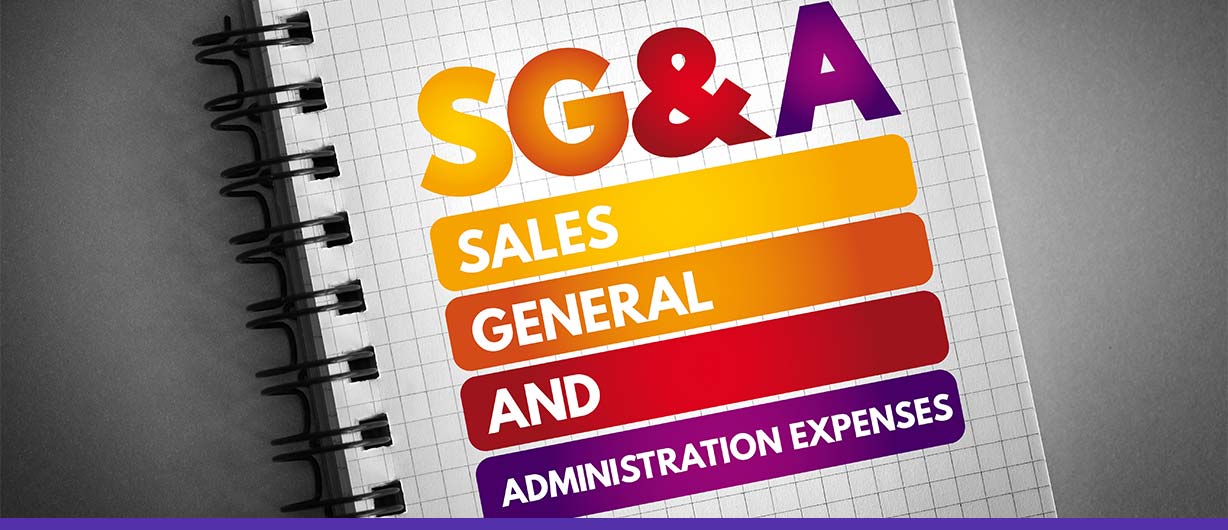June 21 2023 | By Wajiha Danish | 5 minutes Read

What is SG&A?
Here are the steps to calculate SG&A expenses
Step 1:
Step 2:
Step 3:
Step 4:
Step 5:
What are the differences between selling general and administrative expenses?
How to interpret SG&A expenses?
Research industry benchmarks
Compare the company’s SG&A expenses to industry benchmarks
Analyze the company’s cost structure
Consider the company’s growth stage
Look for trends over time
Conclusion
SG&A stands for Selling, General, and administrative expenses. It is an accounting term that describes the costs associated with running a business that is not directly related to producing goods or services.
Selling expenses are the costs of promoting and selling a company’s products or services. This includes advertising, sales commissions, trade shows, and other marketing expenses. General expenses are costs not directly associated with producing or selling a company’s products or services. This includes rent, utilities, office supplies, and other overhead costs.
Administrative expenses are costs associated with the management and administration of a company. This includes salaries and benefits for executives, legal and accounting fees, and other administrative costs.
Determine the period for which you want to calculate SG&A expense. For example, calculate the SG & A expense for the entire year or a particular quarter.
Gather all the necessary financial statements, including the income statement, balance sheet, and cash flow statement.
Identify all the expenses that fall under SG&A. These expenses may include salaries and wages, rent, utilities, office supplies, insurance, travel, marketing, and other expenses related to selling, general, and administrative activities.
Add up all the expenses that fall under SG&A for your chosen period.
Once you have the total expenses, divide it by the company’s total revenue for the same period. The result is the SG&A expense ratio, which measures how much of the company’s revenue goes towards SG&A expenses.
Example:
Here is an example of how to calculate SG&A expenses:
Suppose a company wants to calculate its SG&A expenses for the year 2022.
The following information is available:
– Salaries and wages: $500,000
– Rent: $100,000
– Utilities: $50,000
– Office supplies: $20,000
– Insurance: $30,000
– Travel expenses: $10,000
– Marketing expenses: $50,000
– Total revenue for the year 2022: $2,000,000
To calculate the SG&A expense for the year 2022, we add up all the expenses that fall under SG&A:
SG&A expense = salaries and wages + rent + utilities + office supplies + insurance + travel expenses + marketing expenses
SG&A expense = $500,000 + $100,000 + $50,000 + $20,000 + $30,000 + $10,000 + $50,000
SG&A expense = $760,000
Next, we divide the SG&A expense by the total revenue for the same period:
SG&A expense ratio = SG&A expense / Total revenue
SG&A expense ratio = $760,000 / $2,000,000
SG&A expense ratio = 0.38 or 38%
Therefore, the company’s SG&A expense for the year 2022 is $760,000, and its SG&A expense ratio is 38%. This means that 38% of the company’s revenue goes towards SG&A expenses.
SG&A (Selling, General, and Administrative) and operating expenses are both important aspects of a company’s finance, but there are some differences between them.
SG&A expenses are typically the costs of selling and promoting a company’s products or services. This includes advertising, marketing, sales commissions, and other selling costs. General and administrative expenses include the expenses related to running the overall business, such as salaries, rent, utilities, and office supplies.
On the other hand, operating expenses include all the expenses incurred in the regular course of business operations, including the cost of goods sold, wages and salaries, depreciation and amortization, rent and utilities, and other expenses directly related to producing and selling a company’s products or services.
Therefore, while SG&A expenses are focused on selling and promoting the company’s products or services, general and administrative expenses are focused on running the business. In contrast, operating expenses are focused on the day-to-day operations required to produce and sell those products or services.
Interpreting SG&A (Selling, General, and Administrative) expenses by industry involves understanding the typical cost structures of different types of businesses and comparing the SG&A expenses of a particular company to industry benchmarks.
Here are some steps to follow when interpreting SG&A expenses by industry:
Look for benchmarks or averages for SG&A expenses in the company’s industry. This information may be available from industry associations, financial publications, or investment research firms.
Once you have identified industry benchmarks, compare the company’s SG&A expenses to these benchmarks. If the company’s SG&A expenses are significantly higher than industry averages, it may indicate that it is inefficient in its operations or has excessive administrative costs.
SG&A expenses include various costs, including salaries, rent, utilities, marketing expenses, and other overhead costs. Analyze the company’s cost structure to understand where most of its SG&A expenses come from. This helps you identify areas where the company can reduce costs or improve efficiency.
Early-stage companies may have higher SG&A expenses as they invest in building their brand and establishing their operations. On the other hand, established companies may have lower SG&A expenses as they have established their brand and have more efficient operations.
Look at the company’s SG&A expenses to identify any trends. If the company’s SG & A expenses are consistently increasing, it may struggle to control costs or invest heavily in growth opportunities. On the other hand, if SG&A expenses decrease over time, it may indicate that the company is becoming more efficient in its operations.
In conclusion, SG&A is a critical financial metric that helps businesses measure their efficiency and effectiveness in managing their day-to-day operations. It includes all the expenses incurred in running the business, such as salaries, rent, utilities, and other overhead costs, but excludes expenses related to production and manufacturing. By tracking SG&A, businesses can identify areas to reduce costs and optimize their spending to improve profitability.
Also Read: COGS vs Expenses: What’s the Difference?
Subscribe for business tips, tax updates, financial fundamentals and more.
MORE BLOGS

If you’re a small business, we will absolutely get it if you say you’re having a hard time choosing a payment platform for your company. And […]
Learn More →
When it comes to accounting, businesses often face a confusing question: which accounting method should we adopt? The choice typically boils down to the cash basis […]
Learn More →
Driving for Uber or delivering with Uber Eats can be a flexible and rewarding way to earn money. But when tax season rolls around, many drivers […]
Learn More →